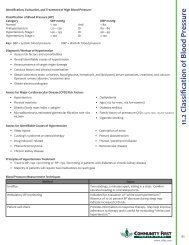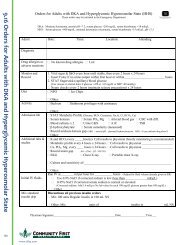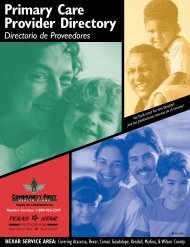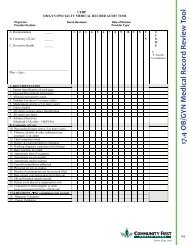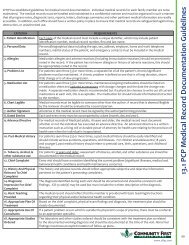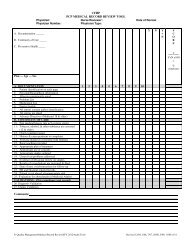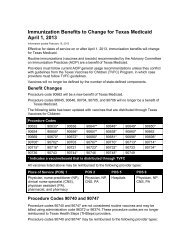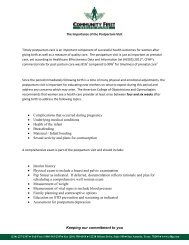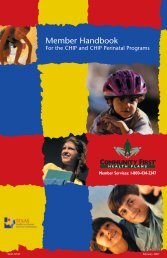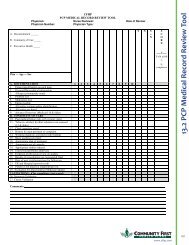Full Clinical Guidelines - Community First Health Plans.
Full Clinical Guidelines - Community First Health Plans.
Full Clinical Guidelines - Community First Health Plans.
You also want an ePaper? Increase the reach of your titles
YUMPU automatically turns print PDFs into web optimized ePapers that Google loves.
possible), a careful, complete, and detailed history should be obtained from the caregivers.<br />
Explanations that are concerning for intentional trauma include:<br />
1. no explanation or vague explanation for a significant injury;<br />
2. an important detail of the explanation changes dramatically;<br />
3. an explanation that is inconsistent with the pattern, age, or severity of the injury or injuries;<br />
4. an explanation that is inconsistent with the child’s physical and/or developmental capabilities; and<br />
5. different witnesses provide markedly different explanations for the injury or injuries.<br />
Information regarding the child’s behavior before, during, and after the injury occurred, including feeding times and levels<br />
of responsiveness, should be gathered. Victims of significant trauma usually have observable changes in behavior. Access to<br />
caregivers and caregiver activities before, during, and after the injury occurred are also important to document. Frequently,<br />
infants and children present to medical settings with a history of a fall. Recent studies have indicated that short falls may result<br />
in bruising; however, more significant types of head trauma, including skull fractures, are exceedingly uncommon but possible.<br />
Information should be gathered in a non-accusatory but detailed manner. Other information that may be useful in the medical<br />
assessment of suspected physical abuse includes:<br />
1. past medical history (trauma, hospitalizations, congenital conditions, chronic illnesses);<br />
2. family history (especially of bleeding, bone disorders, and metabolic or genetic disorders);<br />
3. pregnancy history (wanted/unwanted, planned/unplanned, prenatal care, postnatal complications, postpartum<br />
depression, delivery in non-hospital settings);<br />
4. familial patterns of discipline;<br />
5. child temperament (easy to care for or fussy child);<br />
6. history of past abuse to child, siblings, or parents;<br />
7. developmental history of child (language, gross motor, fine motor, psychosocial milestones);<br />
8. substance abuse by any caregivers or people living in the home;<br />
9. social and financial stressors and resources; and<br />
10. violent interactions among other family members.<br />
AMERICAN ACADEMY OF PEDIATRICS:<br />
The Evaluation of Sexual Abuse in Children<br />
Nancy Kellogg, MD and the Committee on Child Abuse and Neglect<br />
PEDIATRICS Vol. 116 No. 2 August 2005, pp. 506-512<br />
Physicians should be aware that child sexual abuse often occurs in the context of other family problems, including physical<br />
abuse, emotional maltreatment, substance abuse, and family violence. If these problems are suspected, referral for a more<br />
comprehensive evaluation is imperative and may involve other professionals with expertise needed for evaluation and<br />
treatment. In difficult cases, pediatricians may find consultation with a regional child abuse specialist or assessment center<br />
helpful.<br />
<strong>Guidelines</strong> for Making the Decision to Report Sexual Abuse of Children<br />
History<br />
Behavioral<br />
Symptoms<br />
Data Available<br />
Physical<br />
Examination<br />
Clear Statement Present or Absent Normal or<br />
abnormal<br />
None or vague Present or Absent Normal or<br />
nonspecific<br />
None or vague Present or Absent Concerning or<br />
diagnostic findings<br />
Vague, or history<br />
by parent only<br />
Present or Absent<br />
Normal or<br />
nonspecific<br />
Diagnotic Tests<br />
Positive or<br />
negative<br />
Positive test for<br />
C trachomatis,<br />
gonorrhea, T<br />
vaginalis, HIV,<br />
syphilis, or herpes*<br />
Negative or<br />
positive<br />
Level of Concern<br />
About Sexual<br />
Abuse<br />
High<br />
High<br />
High 1<br />
Response<br />
Report Decision<br />
Report<br />
Report<br />
Report<br />
Negative Indeterminate Refer when<br />
possible<br />
None Present Normal or<br />
nonspecific<br />
Negative Intermediate Possible report + ,<br />
refer, or follow<br />
*: If nonsexual transmission is unlikely or excluded.<br />
1: Confirmed with various examination techniques and/or peer review with expert consultant.<br />
+: If behaviors are rare/unusual in normal children<br />
H EALTH PLANS<br />
www.cfhp.com<br />
41



